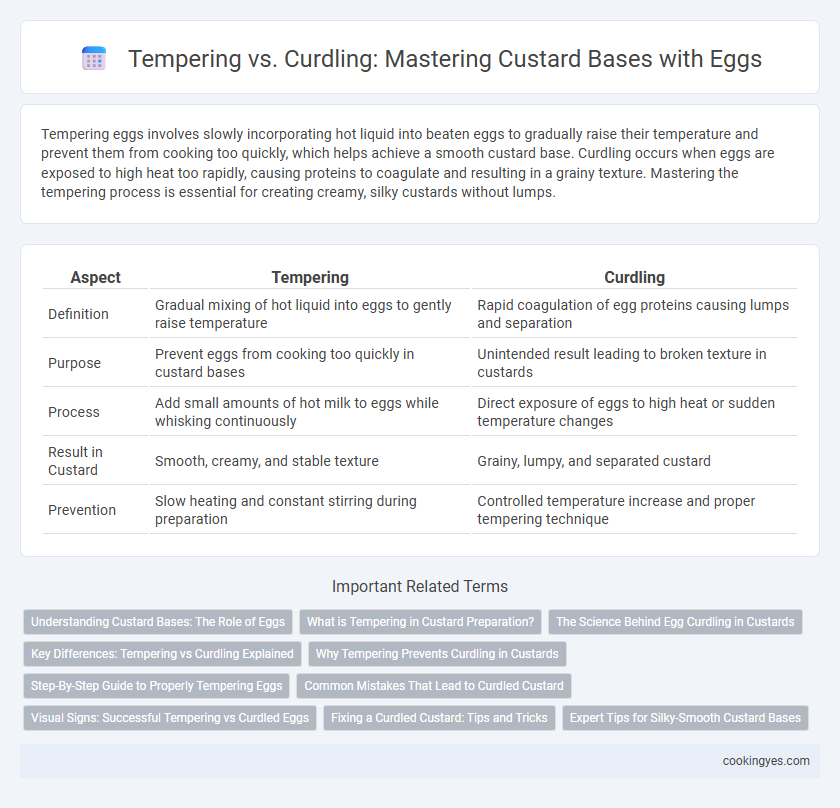Tempering eggs involves slowly incorporating hot liquid into beaten eggs to gradually raise their temperature and prevent them from cooking too quickly, which helps achieve a smooth custard base. Curdling occurs when eggs are exposed to high heat too rapidly, causing proteins to coagulate and resulting in a grainy texture. Mastering the tempering process is essential for creating creamy, silky custards without lumps.
Table of Comparison
| Aspect | Tempering | Curdling |
|---|---|---|
| Definition | Gradual mixing of hot liquid into eggs to gently raise temperature | Rapid coagulation of egg proteins causing lumps and separation |
| Purpose | Prevent eggs from cooking too quickly in custard bases | Unintended result leading to broken texture in custards |
| Process | Add small amounts of hot milk to eggs while whisking continuously | Direct exposure of eggs to high heat or sudden temperature changes |
| Result in Custard | Smooth, creamy, and stable texture | Grainy, lumpy, and separated custard |
| Prevention | Slow heating and constant stirring during preparation | Controlled temperature increase and proper tempering technique |
Understanding Custard Bases: The Role of Eggs
Eggs play a crucial role in custard bases by providing structure through the coagulation of proteins when heated. Tempering eggs by slowly incorporating hot liquid prevents premature protein tightening, ensuring a smooth, creamy texture without curdling. Overheating or rapid temperature changes cause curdling, where proteins clump, separating from the liquid and resulting in a grainy custard consistency.
What is Tempering in Custard Preparation?
Tempering in custard preparation involves slowly warming beaten eggs by gradually adding a hot liquid, such as milk or cream, to prevent the eggs from curdling or scrambling. This controlled heating method stabilizes the proteins in the eggs, ensuring a smooth and creamy texture in the final custard. Proper tempering is essential for achieving a rich, velvety custard without lumps or graininess.
The Science Behind Egg Curdling in Custards
Egg curdling in custard occurs when proteins in the egg coagulate too rapidly or at excessively high temperatures, causing a grainy texture instead of a smooth custard. Proper tempering gradually raises the egg mixture's temperature, allowing proteins to denature evenly and form a stable network that traps liquid, resulting in creamy custard. Understanding this delicate protein transformation is essential to prevent curdling and achieve the ideal custard consistency.
Key Differences: Tempering vs Curdling Explained
Tempering involves gradually heating eggs by slowly adding hot liquid to prevent sudden coagulation, ensuring a smooth custard base. Curdling occurs when eggs are exposed to high heat too quickly, causing proteins to coagulate and form unwanted lumps. Proper tempering maintains a creamy texture, while curdling results in a grainy, separated custard.
Why Tempering Prevents Curdling in Custards
Tempering prevents curdling in custards by gradually raising the temperature of eggs, which stabilizes their proteins and prevents sudden coagulation. This controlled heating allows the eggs to blend smoothly with the hot liquid without forming lumps or scrambled textures. Proper tempering ensures a silky, creamy custard base by maintaining the delicate balance needed for even protein denaturation.
Step-By-Step Guide to Properly Tempering Eggs
Tempering eggs involves gradually warming them by slowly whisking hot custard base into beaten eggs to prevent curdling, which occurs when eggs cook too quickly and form clumps. Begin by pouring a small amount of the hot mixture into the eggs while continuously whisking, then slowly add the combined mixture back into the pot to finish cooking over low heat. Maintaining constant stirring and moderate heat ensures a smooth, creamy custard without lumps or graininess.
Common Mistakes That Lead to Curdled Custard
Common mistakes that lead to curdled custard include overheating the egg mixture or adding cold ingredients too quickly, which causes the eggs to scramble rather than blend smoothly. Failing to temper the eggs by slowly incorporating hot liquid prevents gradual temperature adjustment, increasing the risk of curdling. Using high heat instead of gently cooking over low to medium heat disrupts protein coagulation, resulting in a grainy texture instead of a silky custard base.
Visual Signs: Successful Tempering vs Curdled Eggs
Successful tempering of eggs in custard bases results in a smooth, glossy mixture with no visible lumps or graininess, indicating proper heat integration. In contrast, curdled eggs appear as distinct, uneven clumps with a grainy texture, signaling protein coagulation due to overheating. Visual signs such as a consistent, silky texture confirm tempering success, while separation and chunky curds demonstrate curdling failure.
Fixing a Curdled Custard: Tips and Tricks
Tempering eggs involves gradually warming them with hot liquid to prevent sudden coagulation, which helps avoid curdling in custard bases. If a custard curdles, whisking vigorously while gently reheating over low heat can sometimes smooth the texture, restoring creaminess. Straining the mixture through a fine sieve removes any lumps, making the custard silky and preventing a grainy consistency.
Expert Tips for Silky-Smooth Custard Bases
Maintaining a precise temperature between 140degF to 160degF during tempering prevents egg proteins from coagulating prematurely, ensuring a silky-smooth custard base. Gradually whisking hot liquid into beaten eggs stabilizes the mixture and reduces the risk of curdling caused by sudden heat shocks. Using a double boiler method provides gentle, consistent heat crucial for achieving perfect custard texture without graininess or separation.
Tempering vs Curdling for custard bases Infographic

 cookingyes.com
cookingyes.com